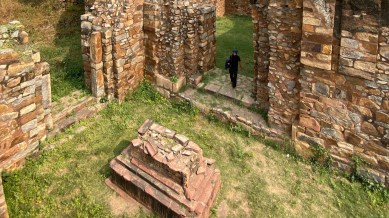Stay updated with the latest - Click here to follow us on Instagram
An abode for fugitives to an architectural landmark: The story of Balban’s Tomb
A few weeks ago, Lieutenant Governor VK Saxena unveiled six renovations nestled inside the park, one among which was the tomb of Balban.

Built in the 13th century and now renovated from ruins, the Tomb of Balban located inside Mehrauli’s Archaeological park has served many purposes in its lifetime: an abode for debtors and fugitives, a slave-turned-Sultan’s Tomb, and a landmark in India’s architectural history.
Ghiyas-ud-din Balban, a Sultan of the Mamluk (Slave) dynasty— the first of the Delhi Sultanate dynasties — ruled from Delhi between 1266 AD and 1287 AD.
monthly limit of free stories.
with an Express account.
Balban was sold as a slave to the then-ruler Iltumish in 1232 CE, who later released him. Historian and author Swapna Liddle said that “individuals captured as slaves during that particular period then rose to become rulers,” giving the period its name.
Liddle told The Indian Express that the tomb “is a very important structure as it shows us the first use of the true arch construction in India”
According to the official website of the Ministry of culture, “Ghiyas-ud-din Balban, one of the most powerful slave sultans after Iltumish, is buried within the archaeological park, in a building once built by the Sultan himself called the Dar-ul-Amaan (Haven of Safety)”.
“Unlike the corbelled arches of Qutub Complex, the true arches of Balban’s tomb have the keystone placed at the centre, which evenly distributes the weight of the superstructure. From here on, True arches became a common feature of the Indo-Islamic architecture of Delhi,” said the website, explaining its architectural significance.
A few weeks ago, Lieutenant Governor VK Saxena unveiled six renovations nestled inside the park, one among which was the tomb of Balban.
“It’s a square building with spacious rooms on either side… it is the same place where his son Sher Khan, Khan e Shaheed was interred only two years before him. However, only one grave is extant now,” wrote author Rana Safvi in her book Where stones speak: Historical Trails in Mehrauli, the First City of Delhi.
“…from afar it looks very unattractive… To reach it, one has to scramble down from the Jamali Kamali mosque by following the ASI markers. Steep steps lead down from it to the ruins…. The Sultan was buried in this building, and I have visited his tomb,” wrote Safvi.
Safvi cites Ibn Batuta, where he had referred to this structure, The Dar-ul- Amaan, as “One of his acts of generosity”.
The structure served as a sanctuary for debtors and fugitives, offering refuge from debt collectors and angry pursuers.
Even those who had committed murder could find solace within its walls, as the Sultan would compensate the families of the victims. The Dar-ul-Amaan truly embodied its name, meaning
“House of safety” providing protection for all who sought its shelter. “Balban’s tomb was one of the first domes to be constructed, but the dome was long destroyed” said author Sohail Hashmi, who also said that the structure is no longer accessible to people as it is currently locked and closed for visiting.
Safvi – who quotes Maulvi Zafar Hasan – wrote that the Sufi fakirs of Mehrauli and the dargah precincts of Qutub Sahab abound them said this had occurred because Balban was extremely cruel, “his ascension to the throne was marked by bloodletting and this could be the reason his afterlife is cursed”.